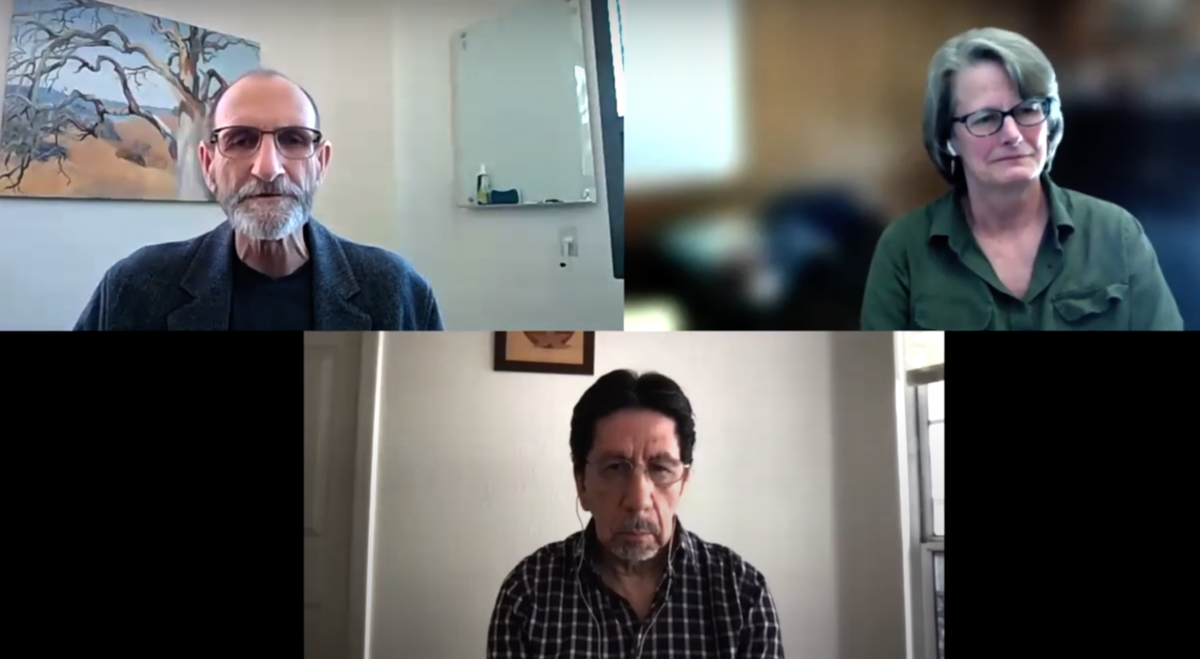The Woods Institute is now part of the Stanford Doerr School of Sustainability
Discussing the Extinction Crisis

Up to 1 million animal and plant species are now threatened with extinction, according to a UN report from the Intergovernmental Science-Policy Platform on Biodiversity and Ecosystem Services (IPBES) on the unprecedented and accelerating decline of biodiversity on Earth. A new BBC film “Extinction: The Facts” with David Attenborough explains the extinction crisis and highlights the growing threats to the world’s species (Watch the trailer.). On April 14, the Stanford Woods Institute for the Environment hosted a discussion of the film and the extinction crisis with Stanford Biology Professor Elizabeth Hadly, who was interviewed for the BBC production at the Jasper Ridge Biological Preserve, as well as Stanford Biology Professors Rodolfo Dirzo and Paul Ehrlich. Chris Field, Director of the Woods Institute, moderated the discussion on biodiversity loss, zoonotic disease, habitat destruction, and the impact of population rise on the natural systems. Galvanizing people to raise awareness and communicate with policymakers on the urgency of the extinction crisis is a major opportunity with the film, discussed Hadly.
Watch the video of the event.
In the tropics, some of the biodiversity loss is coupled with meeting people’s day to day needs for survival. However, many rural and indigenous communities have a clear sense of the problem, because for many of them, maintaining biodiversity is critical for them for such things as medicinal plants, sustainable hunting and other needs and practices, explained Dirzo. Yet the pressure from global economic forces, for example the appetite for soy production in certain areas to sell to China and other economic powerhouses, has diluted the concern for balance and ecosystem health. It is especially tragic that while the world is losing biodiversity, it is also losing cultural diversity and the significance of how nature works for local people.

The film connects high consumption in rich countries with loss of biodiversity in less developed regions and attempts to educate viewers that their decisions in the marketplace impact species decline. Yet, it is difficult for those in developed nations who are so distant from many of the posterchild species for the extinction crisis such as elephants and tigers, to understand the role they play. The population of western migratory monarch butterflies is declining in the local region near Stanford, down 99% since the 1990s. This is something that Hadly believes helps people in the local area understand that it is not only elephants in Africa that are suffering loses but species right in their own backyards. Insects in particular are suffering serious population declines around the globe with relatively little attention from the public.
While the media attention is often on the extinction of individual species, the extinction of populations is the most dramatic pulse of biological extinction today, explained Dirzo. For rural and indigenous communities, the extinction of populations, when things go extinct for them locally, is what hits the hardest. Dirzo felt the impact and significance of these losses for local communities was addressed in the film but could have used more emphasis. If the honeybee was wiped out of North America, the species would still exist but it would cost the U.S. $20 billion in high quality food, explained Ehrlich. People get services from biodiversity that they are often not aware of, such as pollination. Human beings limit the space for other creatures and plants, move species around (which can include species with disease causing spillover impacts to humans), cause pollution of air, land and water, create monocultures and breed livestock, and deliberately kill things with pesticides, insecticides, and other measures, explained Hadly. “We have replaced wild animals with ourselves and domesticated animals.” This has led to a dramatic decline in species. At the end of the Pleistocene, animal biomass was about 300 million tons, whereas now, it is 1.9 billion tons, most of which is accounted for by domesticated animals and homo sapiens, added Dirzo.
As long as you keep the human enterprise at the current level, you cannot solve the problem of livestock biomass, argued Ehrlich. Reducing the population of human beings gradually and humanely is necessary to achieve this goal. He mentioned a new report by Sir Partha Sarathi Dasgupta, Professor of Economics at the University of Cambridge, that found having a sustainable world and biodiversity with it could be attained with a human population at 3.5 billion. The world is now past 8 billion.
Animal agriculture is a key feature in the extinction crisis linking to deforestation, chemical inputs including poisons and fertilizers, and the high footprint required for each individual. While there are many issues with consumption, meat consumption, particularly cattle agriculture is at the nexus of so many of these issues, explained Field. Human consumption and industrial behavior can change quickly, discussed Ehrlich, who described how the U.S. shifted its focus from cars to tanks after the bombing of Pearl Harbor in 1941. When people view something as a crisis, they are more willing to change behavior and put up with losses in convenience and that is the attitude that is needed for the extinction crisis with regard to meat consumption.
Meat consumption also has public health impacts. Not only are there issues with red meat consumption in human diets, but the impacts of the infrastructure and habitat encroachment associated with animal agriculture on wildlife, increases the interaction of humans and wildfire and the potential for disease transfers and spillovers, argued Dirzo.
The two greatest threats to the environment, the loss of biodiversity and climate change, are linked in that they both have to do with the growth of the human enterprise. However, the solutions to these issues are sometimes in conflict. For example, wind turbines have a large impact on bat mortality, explained Hadly. Both climate and biodiversity experts need to be at the table discussing solutions and it will be hard to achieve environment goals unless that is the case, said Field. Yet, extinction is forever, reminded Hadly, and while there may be a future solution to rising temperatures, the species being lost now are never coming back.
Your Questions Answered
The researchers answered individual questions to continue the conversation on the extinction crisis.
How do we handle trade-offs between extinction and carbon sequestration, e.g. old growth rainforests lose their carbon sequestration capability after about 80 yrs.
Most studies indicate that old growth forests hold more carbon than secondary forests, even if you account for all of the carbon in the harvested material. But more broadly, it is important to recognize that, in our quest to sustain a livable biosphere, it will not work to focus on just one priority, whether that is carbon storage or anything else. We need to manage some places with a focus on carbon, others with a focus on biodiversity, and others with an eye to fire risk reduction.
Isn't increasing biodiversity and soil health a valuable method for sequestering carbon and thus combatting climate change?
Often, it is possible to get win-wins with management practices (often leaving ecosystems largely unmanaged) that increase plant or soil carbon and also protect biodiversity. It isn’t always possible to get this kind of win-win, and it is important to think about the managing for the most important services from every ecosystem and for a balanced portfolio across all ecosystems.
There is a climate change summit coming up sponsored by Joe Biden very focused on emissions. How can we include the biodiversity crisis into the conversation and policy discussions?
The climate summit is very important, but climate is not the only pressing environmental issue. The administration’s 30 by 30 agenda is a great step toward addressing biodiversity conservation, but there is much more to do, on both international and national stages. Commitments to biodiversity like this week’s John Kerry trip to China for climate could make a big difference.
What is the approximate time frame in which you see that the survival of Homo Sapiens is threatened?
The timeframe could be from now on, depending on the chances of nuclear war. However the survival of civilization is more chancy.
If a person has just one kid and never eats beef again, would we be ok? Or can you describe how we might realistically and ethically reduce human poulation size?
Changing individual behavior can help but collective action, including politics and altering institituons and human culture in general, is most critical.
How do we get people to agree that there is a need for the type of changes we have made previously in war times?
We need more narrative and art reframing the situation as more threatening than at least conventional warfare.
Contact Information
Christine H. Black
Associate Director, Communications
650.725.8240
ChristineBlack@stanford.edu
Devon Ryan
Communications Manager
650.497.0444
devonr@stanford.edu
Rob Jordan
Editor / Senior Writer
650.721.1881
rjordan@stanford.edu


